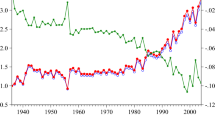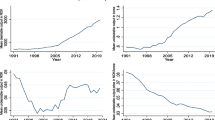Abstract
This paper explores an intermediate route between the Fisher and the Malmquist productivity indexes so as to minimize data requirements and assumptions about economic behavior of production units and their production technology. Assuming quantity data of inputs and outputs and the behavioral hypothesis of allocative efficiency, we calculate the exact value of the Fisher ideal productivity index using implicit shadow prices revealed by the choice of input–output mix. The approach is operationalized by means of a nonparametric data envelopment analysis (DEA) model. Empirical application to Finnish grass silage farms suggests that the Malmquist and the Fisher productivity indices yield similar results when averaged over firms, but there can be major differences in the results of the two approaches at the level of individual firms.
Similar content being viewed by others
References
Afriat, S. (1972). “Efficiency Estimation of Production Functions.” International Economic Review 13(3), 568–598.
Althin, R., R. Färe and S. Grosskopf. (1996). “Profitability and Productivity Changes: An Application to Swedish Pharmacies.” Annals of Operations Research 66, 219–230.
Balk, B. M. (1993). “Malmquist Productivity Indexes and Fisher Ideal Indexes: Comment.” Economic Journal 103, 680–682.
Balk, B. M. (1998). Industrial Price, Quantity, and Productivity Indices: The Micro-Economic Theory and an Application. Boston, Dordrecht, London: Kluwer.
Boumans, M. (2001). “Fisher's Instrumental Approach to Index Numbers.” History of Political Economy 33(5), 313–144.
Caves, D. W., L. R. Christensen and W. E. Diewert. (1982). “The Economic Theory of Index Numbers and the Measurement of Input, Output and Productivity.” Econometrica 50, 1393–1414.
Charnes, A., W. Cooper and E. Rhodes. (1978). “Measuring the Efficiency of Decision Making Units.” European Journal of Operational Research 2(6), 429–444.
Cherchye, L., T. Kuosmanen and G. T. Post. (2000). “What is the Economic Meaning of FDH, A Reply to Thrall.” Journal of Productivity Analysis 13(3), 259–263.
Cherchye, L., T. Kuosmanen and G. T. Post. (2002). “Non-parametric Production Analysis in Non-Competitive Environments.” International Journal of Production Economics 80(3), 279–294.
Diewert, W. E. (1992). “Fisher Ideal Output, Input and Productivity Indexes Revisited.” Journal of Productivity Analysis 3(3), 211–248.
Diewert, W. E. and A. O. Nakamura. (2003). “Index Number Concepts, Measures and Decompositions of Productivity Growth.” Journal of Productivity Analysis 19(2–3), 127–159.
Eichhorn, W. and J. Voeller. (1976). Theory of the Price Index. Berlin: Springer-Verlag.
Färe, R. and S. Grosskopf. (1992). “Malmquist Productivity Indexes and Fisher Ideas Indexes.” Economic Journal 102, 158–160.
Färe, R., S. Grosskopf, B. Lindgren and P. Roos. (1994a). Productivity Developments in Swedish Hospitals: A Malmquist Output Index Approach. In A. Charnes, W. W. Cooper, A. Y. Levin, and L. M. Seiford (eds.), Data Envelopment Analysis: Theory Methodology and Applications. Boston: Kluwer.
Färe, R., S. Grosskopf, M. Norris and Z. Zhang. (1994b). “Productivity Growth, Technical Progress, and Efficiency Change in Industrialized Countries.” American Economic Review 84(1), 66–83.
Färe, R. and C. A. K. Lovell. (1978). “Measuring the Technical Efficiency of Production.” Journal of Economic Theory 19, 150–162.
Farrell, M. J. (1957). “The Measurement of Productive Efficiency.” Journal of the Royal Statistical Society Series A 120(3), 253–290.
Fisher, I. (1922). The Making of the Index Numbers. Boston: Houghton Mifflin.
Fried, H., C. A. K. Lovell and P. Schmidt. (1993). The Measurement of Productive Efficiency: Techniques and Applications. Oxford: Oxford University Press.
Georgescu-Roegen, N. (1951). The Aggregate Linear Production Function and Its Applications to von Neumann's Economic Model. In T. Koopmans (ed.), Activity Analysis of Production and Allocation. New York: John Wiley & Sons Inc.
Jorgenson, D. W. and Z. Griliches. (1967). “The Explanation of Productivity Change.” Review of Economic Studies 34, 249–283.
Kuosmanen, T. (2003). “Duality Theory of Non-convex Technologies.” Journal of Productivity Analysis 20(3), 273–304.
Kuosmanen, T. and G. T. Post. (2001). “Measuring Economic Efficiency with Incomplete Price Information: With an Application to European Commercial Banks.” European Journal of Operational Research 134(1), 43–58.
Kuosmanen, T. and G. T. Post. (2002). “Nonparametric Efficiency Analysis under Price Uncertainty: A First-Order Stochastic Dominance Approach.” Journal of Productivity Analysis 17(3), 183–200.
Lovell, C. A. K. (2001). “The Decomposition of Malmquist Productivity Indexes.” Journal of Productivity Analysis 20(3), 437–458.
Ray, S. C. and E. Desli. (1997). “Productivity Growth, Technical Progress and Efficiency Change in Industrialized Countries: Comment.” American Economic Review 87(5), 1033–1039.
Shephard, R. W. (1953). Cost and Production Functions. Princeton: Princeton University Press.
Shephard, R. W. (1970). The Theory of Cost and Production Functions. Princeton: Princeton University Press.
Varian, H. (1984). “The Nonparametric Approach to Production Analysis.” Econometrica 52(3), 579–597.
Author information
Authors and Affiliations
Rights and permissions
About this article
Cite this article
Kuosmanen, T., Post, T. & Sipiläinen, T. Shadow Price Approach to Total Factor Productivity Measurement: With an Application to Finnish Grass-Silage Production. Journal of Productivity Analysis 22, 95–121 (2004). https://doi.org/10.1023/B:PROD.0000034693.38576.94
Issue Date:
DOI: https://doi.org/10.1023/B:PROD.0000034693.38576.94




